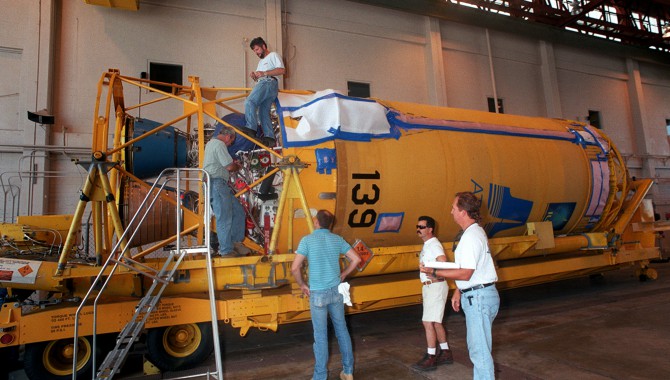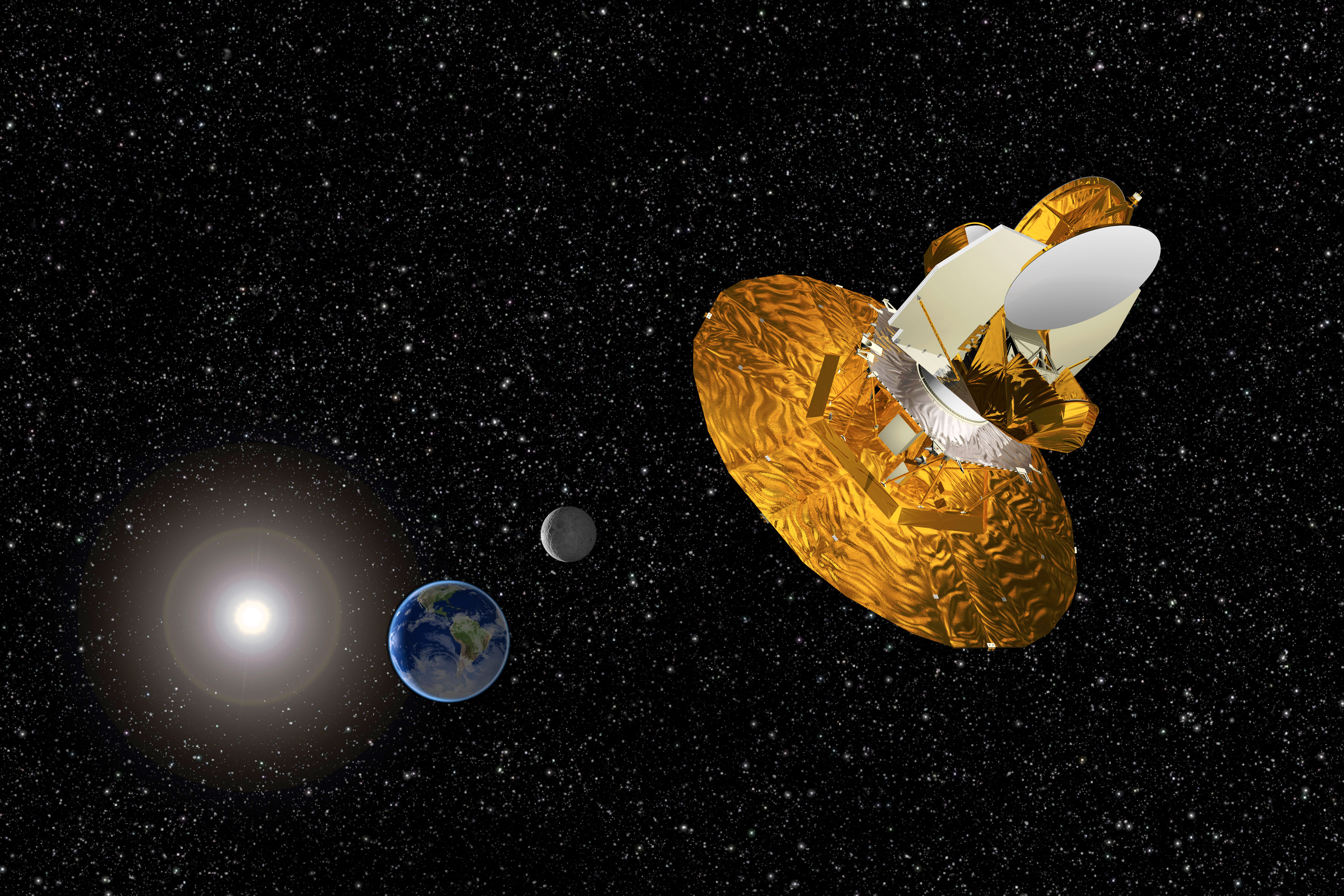
Atlas IIA/Centaur rocket arrives at CCAFS Description: At Hangar J, Cape Canaveral Air Force Station (CCAFS), work is begun on the Centaur upper stage that will be used with an Atlas IIA rocket to launch the latest Tracking and Data Relay Satellite (TDRS) June 29 from CCAFS. The Atlas/Centaur launch vehicle is manufactured and operated by Lockheed Martin. Atlas IIA is capable of lifting payload systems to geosynchronous transfer orbit. Photo Credit: NASA Kennedy Space Center
Twice in my NASA career I have had the opportunity to mentor young assistant mission managers. The first experience occurred when I was mission manager for the International Atmospheric Laboratory for Applications and Science (ATLAS). ATLAS was a series of four missions to map the earth’s atmosphere over the period of one solar cycle. This was the first of the four, a $60 M project with a three-year launch schedule that was extended to four due to Shuttle manifesting slips.
One day shortly after I was assigned the mission management role, my supervisor called me into his office and asked if I would have any problem if they offered me a young woman assistant manager. In the early days of Spacelab missions, there were not as many women engineers in project management at Marshall Space Flight Center (MSFC) as there are today. I was uneasy with this request at first until I found out who the person was. As it turned out, I had met this young woman, Teresa Vanhooser, in the ground operations discipline on a previous mission. She and I had similar ground operations backgrounds. Also, I felt that we could have a good working relationship.
In my mind, three conditions must exist right away between a mentor and mentee. First, they have to be able to get along with each other. Second, both have to make up their minds at the start that they want this experience to work. Third, both have to be open and completely honest with each other. Understand, if all hell breaks loose around them, it’s going to be the two of them against the world.
My approach to working with Teresa was relatively simple. She shadowed me in several key areas, for example, scheduling, budgeting and communications, and as I gained confidence in her I gave her more responsibility. The activities were routine. We started each day by going over the monthly calendar. I assigned her the job of updating it every day. The monthly calendar contained all scheduled meetings, major milestones, deliverables, reviews, and personal leave.
We also forged a daily plan in these meetings. We covered what we’d accomplished the day before as well as what we hadn’t, and we made sure to reschedule any unfinished business. I also asked her to develop the overall master schedule for the mission. The master schedule is the road map that the whole project team uses to understand where we are and where we’re going. I assigned her these jobs thinking it would be an effective way to bring her quickly up to speed on all aspects of the mission.
As the project progressed, the time I invested in Teresa decreased significantly, while her contribution to the project increased markedly. Initially, we went to every meeting together. We spent the first year going over every meeting afterwards in the privacy of my office. I felt we needed to do this so as to develop a common mindset as to where we stood on such things as mission problems, costs, and the schedule, and we also discussed personnel relationships. Effective project management is not just about how to use the tools at your disposal, but how to interact with people and how to understand how others interact. Teresa has excellent people skills and I felt comfortable trusting her intuitions about members of the team.
After a year or so, the schedule of activities proliferated to the point that conflicting engagements prevented us the luxury of both being present at all meetings. This was difficult for me, I have to admit. Although I had no doubt Teresa was capable of representing us at the meetings, it was the first time things really were out of my control. I had to remind myself often that letting go was unavoidable. Indeed, the mentor must allow the mentee to take on more responsibility. It’s the only way she will gain independence and learn for herself. Mentors may find this difficult to do, but it is absolutely necessary.
I handled her involvement with the budget the same way, giving her responsibility as we went along. After two iterations working together to develop the budget with our mission budget analyst, I gave her the responsibility of working individually with the budget analyst, and then had both of them walk me through it line item at a time.
In preparation for major reviews, we first worked on the presentation charts together. Later, she would build some of the charts and I would build others. We would review the package and make appropriate changes as required. Most of the time we had dry runs with upper office management prior to presenting review data to the Center management. At first I had Teresa sit in the back of the room and observe the presentation, and if I were directed to make changes in the presentation material she would record that. This gave her a feel for the people in upper management whom we had to work with. Eventually, when she was on the block herself making these presentations, she already had some experience by watching me take the heat for mistakes and getting grilled by management.
As the mission progressed, and I gained more confidence in her, I gave Teresa signature authority in my absence. In fact, during the final phases of the mission, she chaired several major engineering and operations meetings on my behalf. During the Launch and Flight Mission, which operated 24 hours a day, I managed the flight team on one shift and she managed the team on the second shift.
We completed ATLAS 1 successfully. Afterwards I shifted to a new mission with a new assistant, and Teresa was named Mission Manager for the remainder of the ATLAS series, and she has become an outstanding project manager.
Working with Teresa, and with my next assistant too, was a rewarding experience for me, and I believe serves as an example of how mentoring can be an effective approach of transferring project management knowledge. Once craftsmen passed on their knowledge to the next generation through apprenticeships. Why should it be different with project management?
Teresa Vanhooser says:
The ATLAS-1 mission was very successful and was an outstanding learning opportunity, preparing me to move on to be Mission Manager of the ATLAS-2 mission and later the MSL-1 mission. The mentoring I was so fortunate to experience has influenced many decisions I have made. One important thing I learned and have implemented in my current management style is that every person’s opinion is important and all members of the team should have the opportunity to express themselves.
I think it is important for the mentor and mentee to have compatible personalities. It is also critical for the mentor to show confidence in the mentee and if possible provide increased responsibilities where appropriate. I was given responsibility as well as authority to make decisions regarding the mission without the fear of retribution if I made a mistake.
Lessons
- When mistakes are made, the mentor should accept responsibility for the mistakes and both the mentor and mentee should plan corrective actions to recover.
- For mentoring to work, the mentor and mentee must have mutual respect and trust in each other. They must be committed right from the start to being open and honest with each other.
- Mentoring includes many activities, such as meeting one-on-one, conducting team meetings together and eventually separately, using project tools (e.g., monthly calendar, master schedule), discussing people and relationships, etc.
- The mentee gains valuable independence by gradually assuming more individual responsibility.
About the Author
| Teresa Vanhooser is the mission manager at the Microgravity Science Laboratory (MSL-1) at Marshall Space Flight Center. |








